Assignment 5 Report
1. Introduction
An impressive periodic table in augmented reality that allows students including high school and colleagues to review and interact with the world of 3D neutrons and electrons in the 21st century.
A video describing how the application works can be seen at the below link
There are a couple of improvements compared to the design revisions since Assignment 4:
- The chemical element configuration is read aloud and displayed in text on the screen when the element is selected for approximately 3 seconds.
- The application allows zooming in and out of the 3D chemical elements.
2. Technical Development
2.1. Overview
Drag, drop interaction: Lean touch - Lean Drag Translate Rigidbody. The function comes from lean touch in asset stores. The function allows the user to control, move, drag, and drop 3D objects in the application.
Zoom in and zoom out interaction: Lean Pinch Scale. The function comes from lean touch in asset stores. The function provides the user ability to scale up or down the 3D object. So users can look closer at the object, especially a complicated object while using the application.
Voice interaction: Lean Finger Held. The function comes from lean touch in asset stores. It allows the user to touch and hold for a few seconds to hear the information from the object.
Chemical reaction: OnImageCollisionHandler, NaOHHandle. Those two functions handle the chemical reaction of the application. When the object comes closer enough, the chemical reaction happens and it will create a new object.
Voice interaction: Speech Recognition using Google Cloud (testing). Users can use their voices to control and interact with the application. The function is still in the testing process.
2.2. Detailed explanation of key technical development aspects
LeanSelectable (LeanTouch) defines an object that is selectable by touch.
LeanSelectablebyFinger (leanTouch) defines an object that can be selected and manipulated by Lean Touch.
LeanFingerHeld (LeanTouch) defines an action or a reaction that can be performed by holding an object for a period of time.
LeanDragTranslateRigibody (LeanTouch) defines an object that can be dragged by touch.
LeanPinchScale (LeanTouch) allows an object to be scaled up or down by pinch on the object.
OnImageCollisionHandler script makes two chemical elements ( hydrogen and oxygen) that can react and produce new objects.
OnImageCollisionHandler is similar to OnImageCollisionHandler but it makes for water and natri with special effects. Rotate script makes an object rotate around with a defined speed.
3. 3D Content
This is the 3D of NaOH + 2H and is needed to illustrate explosion of the chemical reaction.
| Models | Thumbnails | Description and justification |
| WaterH2O |  | This is the 3D model of water.
Water is the basic chemical compound and polar molecule example that is used in most chemical lessons. It is essential to start with a very basic, small but the most expensive chemical teaching example to ensure the feasibility of the technical development as well as to make sure that we can finish and deliver to early customers.
|
| Water drop | | This is the 3D model of a water drop.
The water drop needed to illustrate the interactive nature of chemical reactions (chemical bonds) to learn the formula and equations. This model is a crucial part of the experiment. |
| Hydrogen |  | This is the 3D model of hydrogen and is another crucial component of the experiment |
| Oxygen |  | This is the model of oxygen and is another crucial component of the experiment. |
| NaOH + 2H |  | This is the 3D of NaOH + 2H and is needed to illustrate the explosion of the chemical reaction. |
| Alphabet | 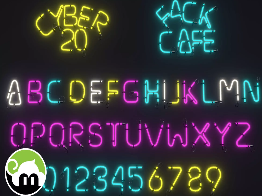 | This is the 3D alphabet model and is needed to generate the NaOH + 2H model as there is no existing model in the unity store. |
4. Usability Testing
4.1. Design and plan
The testing was conducted to evaluate the usability testing by using Google Form survey (Victor 2019), and according to Jenn (2006), questionnaires are useful to collect data from target users. There are 18 questions created to evaluate the VR periodic table which could refer to Appendix. The Google Form was completed on 17 Oct and the survey had taken from 18 to 21 Oct 2022. Quantitative data was collected over the internet after participants filled up the form, and then transformed into pie charts for the data analysis.
Scope of testing:
- Interaction 1: Interacting with the 3D neutron and electrons in the virtual world by selecting the picture of a chemical element in the periodic table to view its configuration.
- Interaction 2: Presenting interactive native chemistry by moving the atoms close to each other to form a new compound.
- Zooming in and out of the 3D chemical elements
Nice-to-have features but this feature is not included in this current development:
- Interaction 3: Extracting atomic components of a molecule by scanning its physical object
4.2. Recruitment Participants
Twenty-five qualified individuals were surveyed for this application. We poll not just high school students, but also chemistry teachers, since we require unbiased feedback from those with experience and knowledge of the subject. Our survey has no age, gender, or cultural restrictions. Invitations to participate in this survey were posted on the Facebook pages of several high schools and sent to chemistry instructors and students.

4.3. Report of findings
4.3.1. Easy to use

High school students would benefit from using this application to study the periodic table. Over 79% of those who answered agreed that high schools could easily use the design and idea behind the AR periodic table. When asked to compare the AR version to the traditional form, 84% of the respondents who took part said that the AR version was easier to use. In addition, nobody seemed to have any disagreements while using this app. Almost 60% of users say that the program is easy to use and has no problems on the first try and a minority (8%) is unable to use it at the first time effort.
4.3.2. Practical and useful function
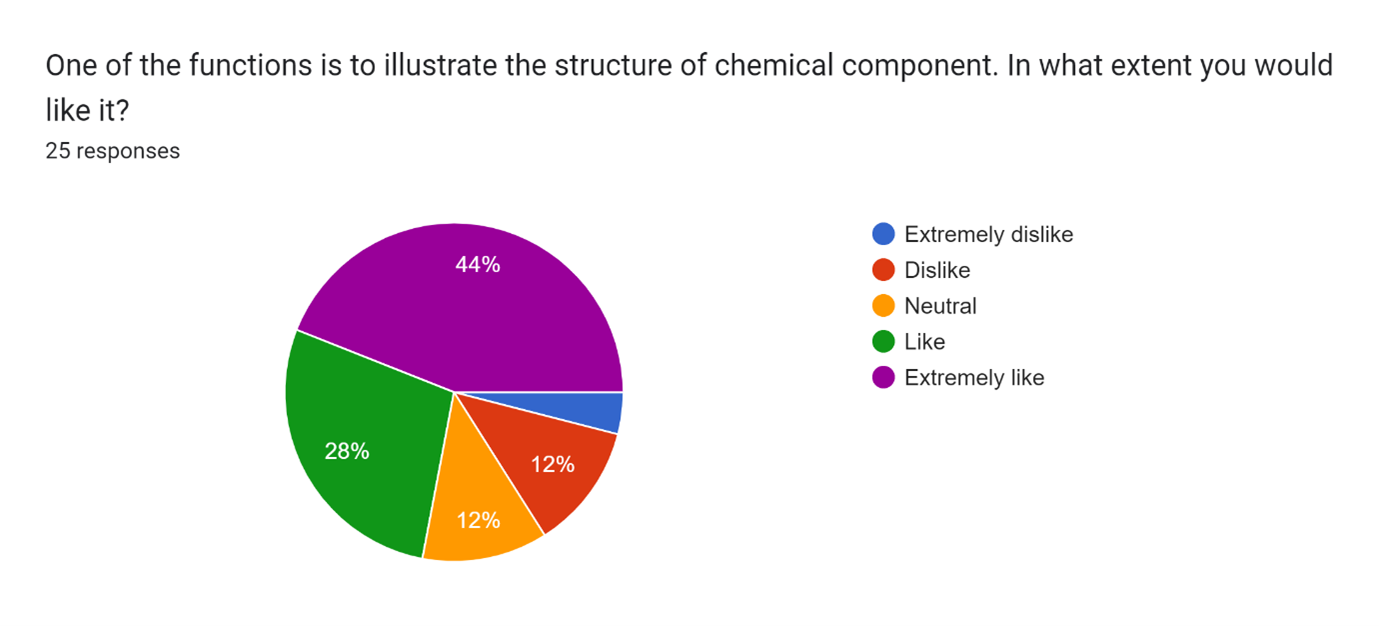
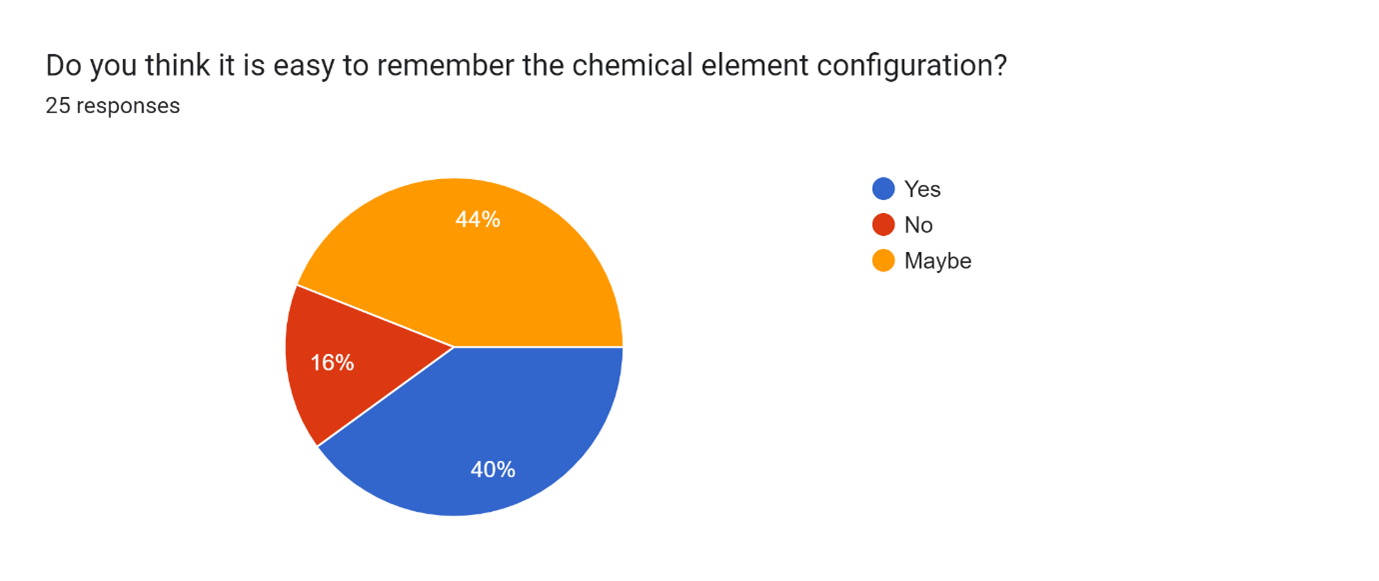
High school students would benefit from using this application to study the periodic table. Over 79% of those who answered agreed that high schools could easily use the design and idea behind the AR periodic table. When asked to compare the AR version to the traditional form, 84% of the respondents who took part said that the AR version was easier to use. In addition, nobody seemed to have any disagreements while using this app. Almost 60% of users say that the program is easy to use and has no problems on the first try and a minority (8%) is unable to use it at the first time effort.
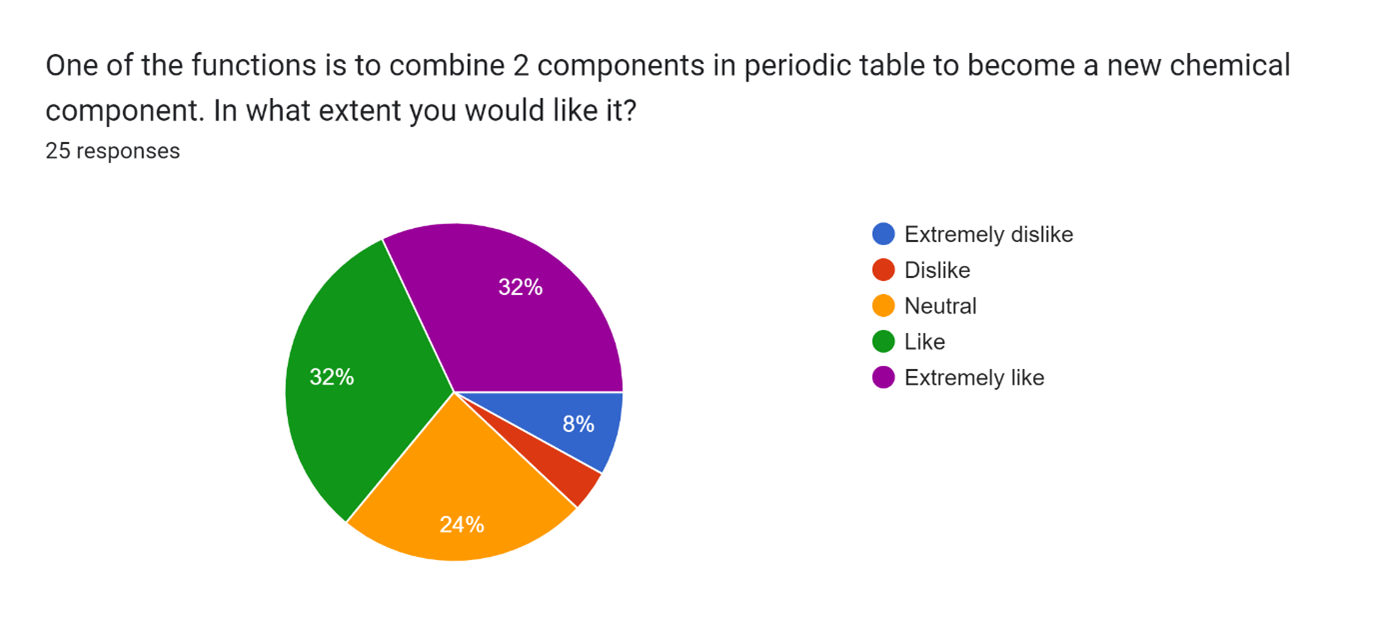
The ability to create new pieces by merging two existing ones has been well-received by users. 64% of respondents (32% really like and 32% like) have positive feedback while 24% of respondents give it a neutral rating . There are only 8% who extremely dislike it and 4% who dislike it.
4.3.3. Able to adapt to high school level
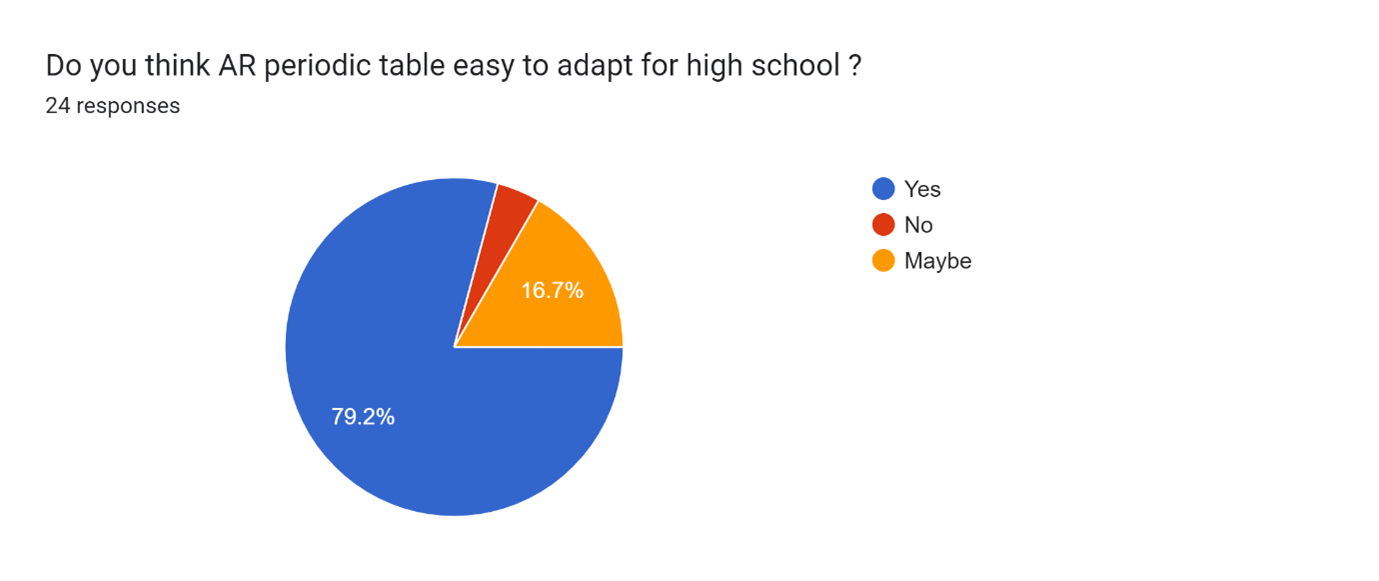
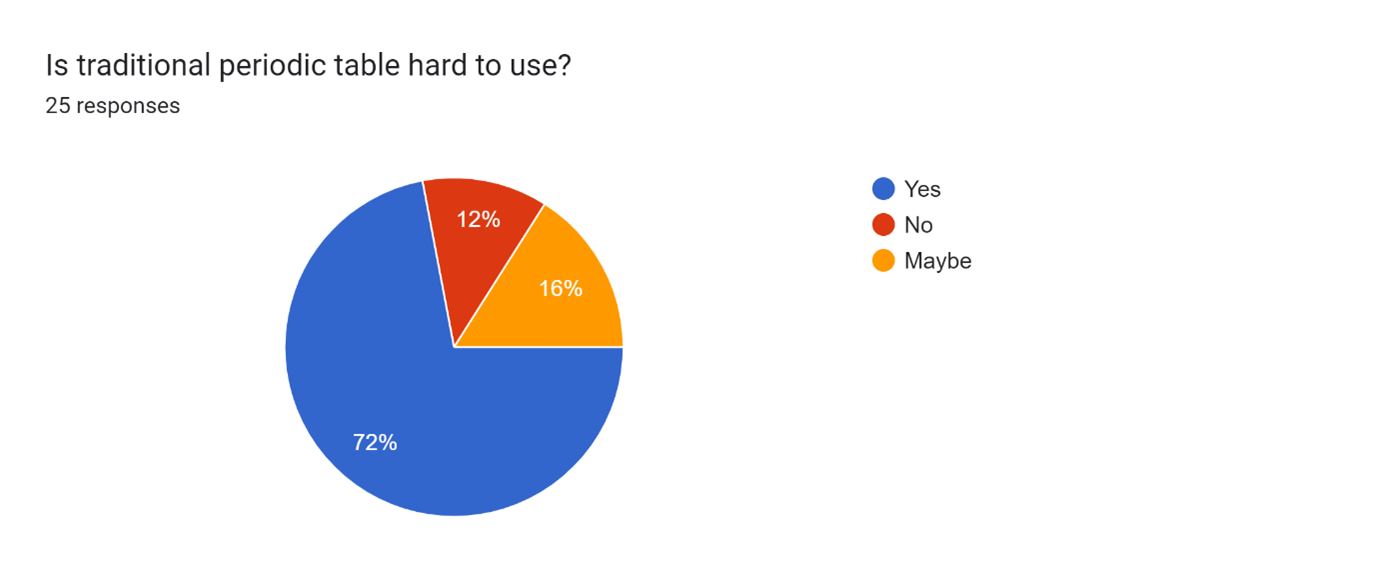
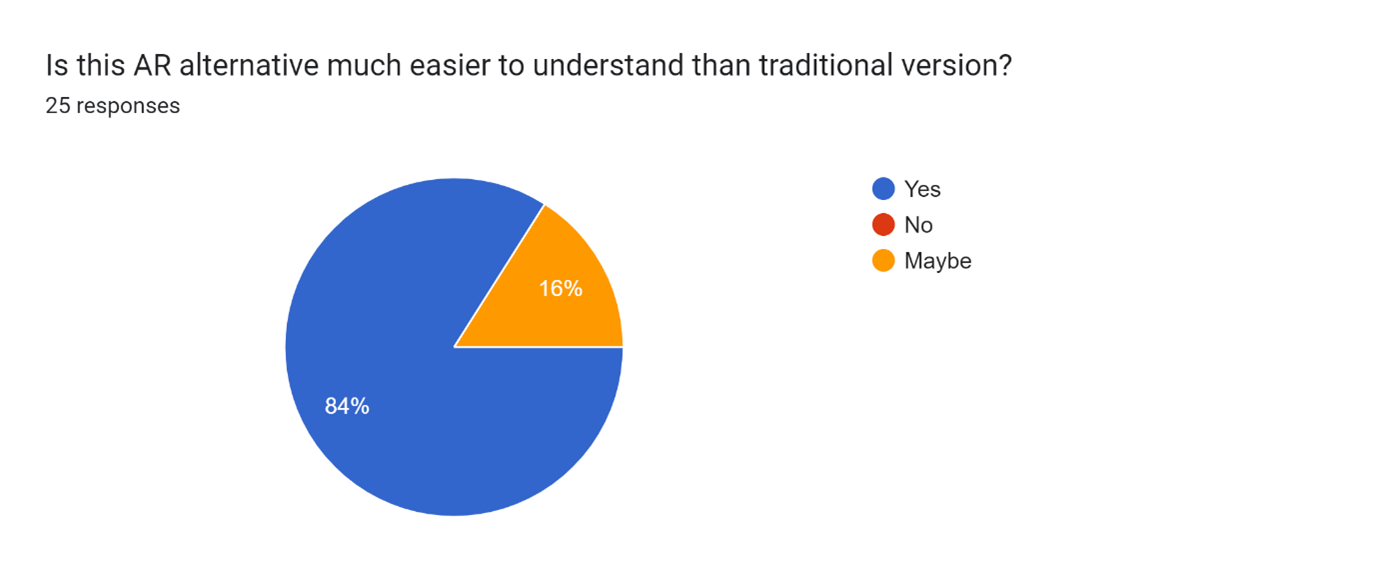
4.4. Analyze of the findings
4.4.1 Meaning of the findings
Regarding the question of the possibility of adapting this app into high school , 79% of the participants agree while 16.7% of respondents disagree. Regarding the question “ is the traditional periodic table hard to use”, 72% of users agree, 16% partly agree and 12% disagree. When they were asked about the comparison of the AR version and the paper’s periodic table, 84% of participants agreed while 16% of them disagreed.
The majority of users find the utility of the application's features to be satisfactory. The application has the potential to be beneficial because the participants agreed that the app is useful, but further experimental data is required because 13% of participants disagreed that the application is useful. Most users also believe that the app is simple to use from the first test, however, 8% still disagree. The application does not really imply a solution for remembering chemical element configuration because 44% of users partly agree and 16% of users do not agree.
The purpose of illustrating the chemical element's structure has the potential to become a useful tool, since just 16% of respondents disagree. The AR function of learning chemical equations received a large number of affirmative responses, while 12% disagreed.
In addition, the evidence suggests that the app has the potential to be extensively used in high school chemistry courses, but a minority (4.2%) disagrees.72% of users have difficulty learning the traditional periodic table, which cannot be denied. Therefore, a huge majority agree that the AR version is far simpler and more practical to learn, with 16% of respondents partially agreeing and no one disagreeing.
4.4.2. The relevant finding with a focused topic
There is convincing evidence that this application accomplishes the aforementioned purpose. The difficulty with the conventional approach is that learning chemistry is difficult because pupils need a firm understanding of mathematics and physical rules in order to comprehend ideas of chemical bonding (Abdinejad et al. 2020). Almost seventy-two percent of respondents, however, think this app may assist learning the AR periodic version clearer.
Furthermore, another issue is that high school pupils are unanimous in their grasp of chemical bonding, with just 50% showing signs of misunderstanding (Fadillah & Salirawati, 2018). The present study, however, reveals that 84% of respondents say the AR periodic table is much easier to use than the old one, indicating the problem has been addressed.
Utilizing a 3D picture in teaching has been found to be more effective than using static visuals in supporting learners to understand difficult concepts (Eze 2015). Forty percent of respondents believed that the app assisted them to grasp the chemical element configuration.
5. Addressing the Results of the Usability Testing
During the course of the usability testing, participants will submit many pieces of feedback. The first thing that the participants want is a comprehensive introduction to the periodic table. The reason for this is that the usability test was carried out in the form of a demo, which means that the functionalities have not been fully created and reviewed. Participants will operate under the assumption that this app is completely completed. Another piece of criticism that was received was that there is no navigation and users request to locate the buttons for managing the functions.
6. References
Abdinejad, M, Talaie, B, Qorbani, HS & Dalili, S 2020, ‘Student perceptions using augmented reality and 3D visualization technologies in chemistry education’, Journal of Science Education and Technology, vol. 30, no. 1, pp. 87–96.
Eze, S 2015, ‘Effect of Visual 3D Animation in Education’, European – American Journals, vol. 1, pp. 1-9.
Fadillah, A & Salirawati, D 2018, ‘Analysis of misconceptions of chemical bonding among tenth-grade senior high school students using a two-tier test’, AIP Conference Proceedings.
Jenn, NC 2006, ‘Designing A Questionnaire’. Malaysian family physician: the official journal of the Academy of Family Physicians of Malaysia, vol.1, pp.5-32.
Sketchfab, 2022, Water Drop, Sketchfab, viewed 26 October, https://sketchfab.com/3d-models/water-drop-9a0a41e2b0f74230850efce53380fd08
Unity Asset Store, The ultimate aplhabetic neon props pacl perfect for decorating cities/cyberpunk scens, Unity Asset Store viewed 26 October 2022, https://assetstore.unity.com/packages/3d/props/exterior/alphabetic-neon-props-16...
Unity Asset Store 2022, Lean Touch, Unity Asset Store viewed 28 October 2022, https://assetstore.unity.com/packages/tools/input-management/lean-touch-30111?aid=1101l4Jks&utm_campaign=unity_affiliate&utm_medium=affiliate&utm_source=partnerize-linkmaker
Victor, O 2019, ‘Data Collection with Google Forms’, ResearchGate, vol. 1, pp. 1-100
Vigoroso, L, Caffaro, F, Cavallo, E & Cremasco, MM 2021, ‘User-centered design to promote the effective
Get KIT724 - Assignment 5 Development and Evaluation of Interface Application
KIT724 - Assignment 5 Development and Evaluation of Interface Application
| Status | Released |
| Authors | nhtn, To Phuong Truong |
